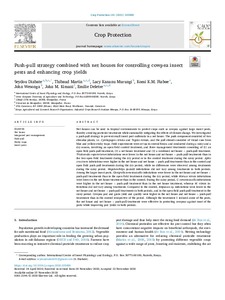| dc.contributor.author | Diabate, S. |
| dc.contributor.author | Martin, T. |
| dc.contributor.author | Murungi, L.K. |
| dc.contributor.author | Fiaboe, K.K. |
| dc.contributor.author | Wesonga, J. |
| dc.contributor.author | Kimani, J.M. |
| dc.contributor.author | Deletre, E. |
| dc.date.accessioned | 2021-07-16T13:20:09Z |
| dc.date.available | 2021-07-16T13:20:09Z |
| dc.date.issued | 2021-03 |
| dc.identifier.citation | Diabate, S., Martin, T., Murungi, L.K., Fiaboe, K.K., Wesonga, J., Kimani, J.M. & Deletre, E. (2021). Push-pull strategy combined with net houses for controlling cowpea insect pests and enhancing crop yields. Crop Protection, 141, 105480: 1-10. |
| dc.identifier.issn | 0261-2194 |
| dc.identifier.uri | https://hdl.handle.net/20.500.12478/7184 |
| dc.description.abstract | Net houses can be used in tropical environments to protect crops such as cowpea against large insect pests, thereby avoiding pesticide treatments while sustainably mitigating the effects of climate change. We investigated a push-pull strategy to prevent small insect pest outbreaks in a net house. The push component consisted of two stimulus plants, i.e. Cymbopogon citratus and Tagetes minuta, and the pull stimuli consisted of visual cues from blue and yellow sticky traps. Field experiments were set up in central Kenya and conducted during a rainy and a dry season, involving an open field control treatment, and three management treatments consisting of (1) an open field push-pull treatment, (2) a net house treatment and (3) a combined net house + push-pull treatment. Trialeurodes vaporariorum infestations were lower in the net house and net house + push-pull treatments than in the two open field treatments during the dry period or in the control treatment during the rainy period. Aphis craccivora infestations were higher in the net house and net house + push-pull treatments than in the control and open field push-pull treatments during the dry period, while no differences were observed among treatments during the rainy period. Megalurothrips sjostedti infestations did not vary among treatments in both periods. Among the larger insect pests, Clavigralla tomentosicollis infestations were lower in the net house and net house + push-pull treatments than in the open field treatments during the dry period, while Maruca vitrata infestations were lower in the net house treatment than in the control. During the rainy period, C. tomentosicollis infestations were higher in the net house + push-pull treatment than in the net house treatment, whereas M. vitrata infestations did not vary among treatments. Compared to the control, Empoasca sp. infestations were lower in the net house and net house + push-pull treatments in both periods, and in the open field push-pull treatment in the rainy period. Cowpea pod and grain yield and quality were higher in the net house and net house + push-pull treatments than in the control irrespective of the period. Although the treatments 1 reduced some of the pests, the net house and net house + push-pull treatments were effective in protecting cowpeas against most of the pests while improving pod yields in both periods. |
| dc.description.sponsorship | German Federal Ministry for Economic Cooperation and Development |
| dc.description.sponsorship | French Agricultural Research Centre for International Development |
| dc.description.sponsorship | Kenya Agricultural and Livestock Research Organization |
| dc.format.extent | 1-10 |
| dc.language.iso | en |
| dc.subject | Cowpeas |
| dc.subject | Pest Insects |
| dc.subject | Integrated Pest Management |
| dc.subject | Climate Change |
| dc.subject | Crop Yield |
| dc.subject | Sticky Traps |
| dc.title | Push-pull strategy combined with net houses for controlling cowpea insect pests and enhancing crop yields |
| dc.type | Journal Article |
| cg.contributor.crp | Roots, Tubers and Bananas |
| cg.contributor.affiliation | International Centre of Insect Physiology and Ecology |
| cg.contributor.affiliation | Jomo Kenyatta University of Agriculture and Technology |
| cg.contributor.affiliation | Centre de Coopération Internationale en Recherche Agronomique pour le Développement |
| cg.contributor.affiliation | Université de Montpellier |
| cg.contributor.affiliation | International Institute of Tropical Agriculture |
| cg.contributor.affiliation | Kenya Agricultural and Livestock Research Organisation |
| cg.coverage.region | Africa |
| cg.coverage.region | East Africa |
| cg.coverage.country | Kenya |
| cg.coverage.hub | Central Africa Hub |
| cg.researchtheme | Natural Resource Management |
| cg.identifier.bibtexciteid | DIABETE:2021 |
| cg.isijournal | ISI Journal |
| cg.authorship.types | CGIAR and developing country institute |
| cg.iitasubject | Agronomy |
| cg.iitasubject | Climate Change |
| cg.iitasubject | Cowpea |
| cg.iitasubject | Grain Legumes |
| cg.iitasubject | Pests of Plants |
| cg.iitasubject | Plant Breeding |
| cg.iitasubject | Plant Production |
| cg.journal | Crop Protection |
| cg.notes | Published online: 25 Nov 2020 |
| cg.accessibilitystatus | Limited Access |
| cg.reviewstatus | Peer Review |
| cg.usagerightslicense | Copyrighted; all rights reserved |
| cg.targetaudience | Scientists |
| cg.identifier.doi | https://dx.doi.org/10.1016/j.cropro.2020.105480 |
| cg.iitaauthor.identifier | Komi Fiaboe: 0000-0001-5113-2159 |
| cg.futureupdate.required | No |
| cg.identifier.issue | : 105480 |
| cg.identifier.volume | 141 |

